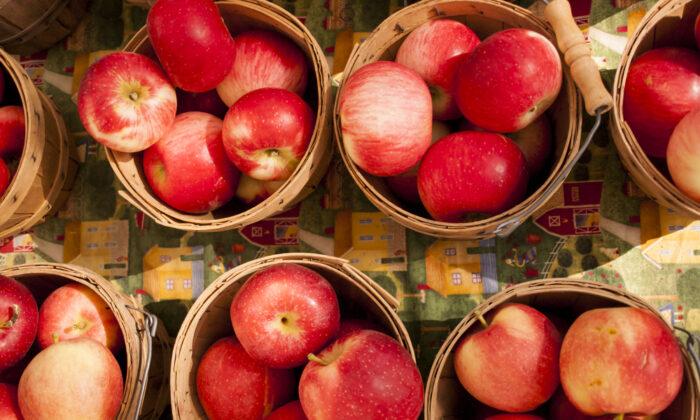A special kind of forest rises up from the rolling valleys of central Asia, surrounded by the jagged, snow-capped peaks of the Tian Shan mountains. Tangled among the brush grow Malus sieversii—the wild apple. Far from the neatly ordered rows of an apple orchard, these wild apple trees grow wherever they please, unfettered by the tending care of orchardists. Whole valleys light up in the spring with exuberant sprays of foamy white flowers before yielding small, plump yellow fruit in the fall.
This valley gave the world the apple tree, one of the most popular and widely cultivated fruits. It wasn’t until 1929 that Russian botanist Nikolai Vavilov traced the modern, domesticated apple (Malus domestica) directly to its wild ancestor, and this genomic connection was reconfirmed in 2010 by a team of international researchers.
The Spread of Apple Seeds
Migration, ancient trade routes, and the Roman Empire’s expansion spurred the spread of apples from this isolated, mountainous region. The little golden fruit was aided by one other benefit: It’s heterozygous, meaning it doesn’t grow true to seed. Rather, if you plant an apple seed, it’s unlikely to carry the traits of its parents. The seed from a sweet apple might yield bitter or sour fruit. Instead, you must graft apples to ensure that a sapling will eventually bear the fruit of its predecessors.In the early 17th century, apple seeds and saplings arrived in the Americas, largely at the request of the Massachusetts Bay Colony. Once planted, the seeds produced widely varied fruit. Farmers developed fruit with desired characteristics into special varietals through grafting and cross-pollination. By the mid-17th century, apple orchards flourished, with nearly 90 percent of farms producing apples. Sweet apples could be eaten fresh, tart cooking apples were perfect for stewing, and bitter and tannic apples found their way to the cider press. What had once been a wild fruit of central Asia had become synonymous with American farms and cookery.
Johnny Appleseed Cultivates America’s Apple
In the early 19th century, apple cultivation spread even more thanks to John Chapman (more colloquially known as Johnny Appleseed), an American pioneer and missionary. He encouraged the spread of apples westward by planting nurseries along the American frontier and selling them to would-be homesteaders. Planting a crop helped pioneers secure their homesteads, and apples were relatively easy to grow.Chapman’s faith forbade grafting, and he grew all his apple saplings from seed. As a result, there was a huge genetic variance among the trees, and their fruit was often inedible but perfect for pressing cider or feeding farm animals.
Modern Varieties
By the late 19th century, the number of apple varieties grown in the United States numbered more than 7,000. While this crop diversity might be celebrated today, it posed a problem for the USDA, a new-found governmental organization charged with standardizing American crops. So many different apples, with unending variations in color, texture, and flavor, meant difficulty in determining what made a good apple and how to market and sell those apples. Accordingly, they discouraged the cultivation of heirloom apples and favored just a small number of cultivars. Currently, only nine standard varieties command more than three-quarters of the market share, with Gala and Red Delicious leading the pack.Now, interest in heritage cooking and sustainable agriculture grows—and along with it, interest in preserving heirloom varietals. Many orchardists now seek heirloom varietals for their unique flavors and hardiness. You’re more likely to find these varieties at farmers markets and farmstands than at a chain grocer, and they’re well worth your time.
Like other apples, heirloom varietals can be divided into four basic categories: cooking apples, dessert apples, dual-purpose apples, and cider apples. Cooking apples have firm flesh and good flavor and are well-suited to pies, sauces, and other cooked foods. Dessert apples are excellent for eating fresh out of hand. Dual-purpose apples are just as good eaten fresh as cooked, and cider apples tend to be woody and tannic. If you’re unsure how best to use the apples you’ve picked at the farm or found at the farmers market, just ask the farmer for insight.
5 Heirloom Varieties to Seek Out
Tompkins King is a large apple with mottled golden-red skin and sweet, sharp flesh. This variety dates to the 1750s and is suitable for both eating fresh and baking.Bramley apples are pale green and speckled with red. They have a hard, crisp flesh and an intense brandy-like apple flavor touched with bright notes of acidity. Its firm flesh and robust flavor make Bramleys excellent for cooking, especially in sauces and pies. The variety was first sold in the mid-19th century.
Snow apples have a delicate yellow color overlaid with pale red. Their sweet flavor makes them perfect for eating fresh. This apple dates to 18th-century Canada.
Mountain Rose apples have muted yellow- and pink-colored skin, but striking scarlet-colored flesh. They taste mildly sweet and pleasantly tart. They retain their red color when cooked, but they’re best eaten fresh out of hand.
Golden Russet apples have rough-textured skin of muted yellow blushed by the slightest pink. They’re deliciously sweet and tart, but their texture is firm. They’re excellent for cooking, juicing, or cider-making and have been cultivated since the 19th century.
RECIPE: Celery Salad With Apples and Hazelnuts
RECIPE: Mulled Apple Cider
RECIPE: Einkorn Apple Cake







